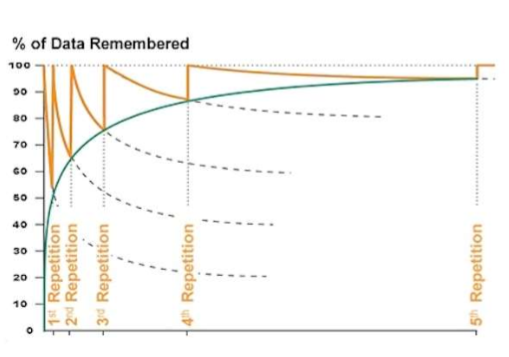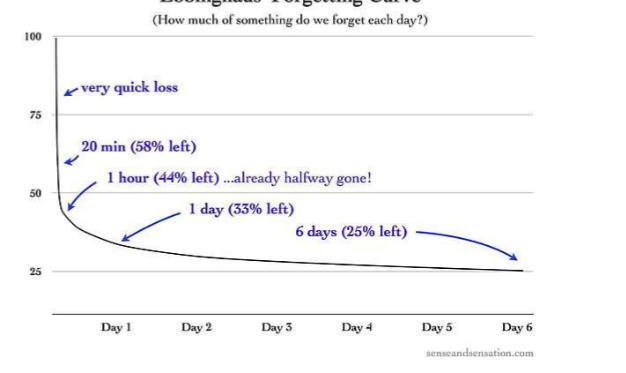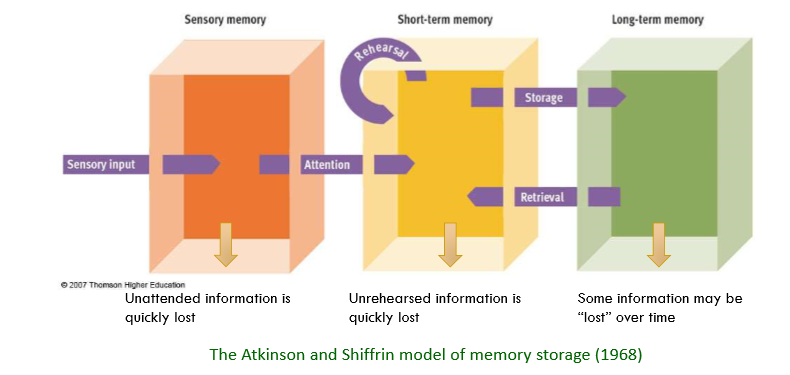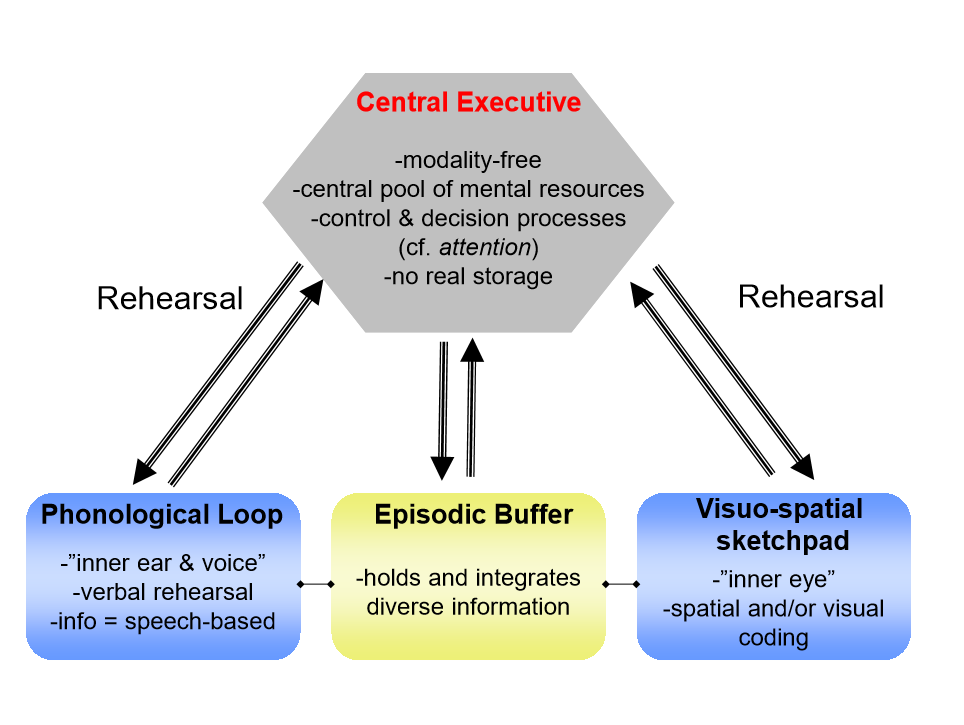W8 - Models of Memory
1/30
There's no tags or description
Looks like no tags are added yet.
Name | Mastery | Learn | Test | Matching | Spaced |
|---|
No study sessions yet.
31 Terms
Hermann Ebbinghaus
First person who studies memory experimentally
Learning - studied CVC (consonant, vowel, consonant) nonsense syllables to exclude prior knowledge
Recall - testing himself the first item and had to recall the rest in the list
Insight into
Learning = Law of Repetition
Forgetting = Savings method
Law of Repetition
When you rehearse something you learn it better
More rehearsal = better retention
Plateaus = first few repetitions give the most benefit

Ebbinghaus’ Forgetting Curve
Soon after learning = forget 50%
Forget most straight away

3 Core Memory Processes
Encoding (paying attention)
Transformation from perceptual representations into attentional focus
Attention - selects what is relevant vs left out
Storage/maintenance
How is a memory kept in focus of attention (STM)
How is it moved to LTM
Retrieval/remembering
Bringing back into focus of attention
Multi-Store Model of Memory
Unattended info is quickly lost
If attended = goes into STM
Unrehearsed = info is lost
If rehearsed = goes into LTM
How long do stores last?
Sensory = msec- secs
STM = secs-mins
LTM = days, years, indefinitely

Sensory memory: Function
Fills in blanks when there is intermittent stimulation (e.g. sparkler looks like a circle) = perception is briefly held in memory
Function:
To keep sensory info in mind so can be attended to
ionic memory (vision)
echoic
haptic
olfactory
gustatory
= forms automatically (doesn’t need attention)
Sensory memory: Capacity Studies
Averbach (1963)
asked how many dots they saw
found: amount of info in iconic memory = 4-5 items
Sperling (1960)
Briefly presented letters in 3×4 matrix
Full report
name as many letters as possible
result = 4 letters
Partial report
sound indicated which row to look at
result = 6 letters
SUM of performance in each row
Sensory memory: Capacity + Duration
Sperling: 2 conclusions
Capacity:
large amount held in ionic memory
Duration:
After 25—500ms approached 4 letters
Info in ionic decays rapidly
Anything left transferred to STM before it was lost
Tone/sound = attention
Attention = info into STM
Short Term Memory
Function:
Conscious processing of info
Attention is key
Capacity is limited:
(Miller, 1956) 7+-2
can be overcome by ‘chunking’ = grouping info together = 7 is an overestimation
Cowan (2000)
4+-1
Luck + Vogel (1997) - if set size > 4 = severe drop in performance
Electrophysiological and neuro-imagine support
Retrieval from STM
(Sternberg, 1966)
2-6 letters presented = within STM capacity
confirm is letter was in set or not
Possibilities:
parallel search (all at same time)
serial self-terminating (stop when found)
serial exhaustive (one after another, continue even when found = CORRECT
CORRECT:
Ppl scan STM in a serial exhaustive way
Scan rate = 38ms per item
STM: Duration
Limited duration:
If not rehearsed = info lost within 15-20 sec
decay + displacement
rehearsal = process of repetitively verbalizing / thinking about the info
CRITCISM of STM: only forgetting due to time delay?
pre-active vs retro-active interference:
Pro-active = something from earlier interferes
Retro-active = something something learnt later affects earlier memory
Release from Pro-active interference:
previous trials generate interference
gradual decline in performance
when nature of stimulus changes (e.g. letter to numbers) = accurate recall again
CRITICISM of STM: only forgetting due to decay?
Interference is most likely the cause for forgetting:
especially at longer intervals
when stimuli are similar
when learning lots of info
when learning info close together in time
when learning in the same context
Other Criticisms of the STM
Info in the STM does not need to be processed consciously
Simple rehearsal does not ensure LTM storage
Learning in STM affected by LTM (e.g. chunking)
Double dissociation found in patients supports STM-LTM distinction
BUT some with impaired STM can still acquire LTM memories
Long Term Memory
Function:
Organises and stores info
Capacity:
Unlimited
Duration:
Permanent
Working Memory
Baddeley + Hitch (1974)
STM:
not just for passive retention
it is necessary for language, mental arithmetic, reasoning etc
WM: Baddeley (1986)
Digit span task: short-long sequence to be rehearsed out loud
= varying demands on limited capacity STM
= varying degrees of interference
coupled with reasoning task
Results:
less slowdown that expected
with 8 items = more than STM capacity = performance should break down
BUT there was not difference in error rate
SO:
even at max digit span = still possible to do other tasks
idea of different subsystems
WM: Diagram
model of STM

Example of using the WM
How many windows in your parents house?
Visuo-s s = imagine house/rooms
Phonological loop = counting windows
Central executive = selecting + running strategy
Episodic buffer = holding + integrating info
WM: How to test capacity of separate components
If 2 tasks use the same components = cannot be performed successfully together
If 2 tasks use different components = should be possible to perform them as well together as separately
= dual-task experiment
WM: Phonological loop
Temporary storage of speech-like info (‘verbal STM’)
2 primary structures:
Phonological store
temporary, passive
limited in time (2sec) + capacity
code = speech-based
Articulatory loop
active rehearsal component
linked to speech
WM: Evidence for phonological loop
Phonological similarity effect
Word length effect
Unattended speech effect
Articulatory suppression effect
PL evidence: Phonological similarity effect
Errors more likely to be phonologically similar to correct item (e.g. F-S and B-G)
More likely to misremember if items sound similar
e.g. ‘mad cap man map’ harder than ‘pen day cow bar rig’ (Baddeley, 1966)
PL evidence: Word length effect
The memory span for short words > long words (can recall more)
Word length effect is due to articulation duration, not syllables = evidence for PL
e.g. span for wicket = bishop > harpoon + labile
same no. of syllables but shorter articulation duration)
This is why ppl of language with a faster articulation rate (e.g. Chinese) have a larger span
PL evidence: Unattended speech effect
Performance impaired if other verbal material needs to be ignored
even w nonsense syllables
even in diff languages
even w vocal music
less with instrumental music
not with white noise
irrelevant spoken material can gain access to phonological store
filter to distinguish between noise + speech
PL evidence: Articulatory supression
Prevent rehearsal by covert articulation (practice silently) = there is overall worse performance
Articulatory suppression (saying ‘thethethe…’) while learning items when to-be-learned item is presented VISUALLY, will:
results in speaker being unable to use sub-vocal articulation
evident = word length effect disappears (sub-vocal articulation required)
to-be-learned item is presented AUDITORILY:
have no effect on sub-vocal articulation bc the tb-learned item has direct access to phonological store
evident = word length effect does NOT disappear
WM: Visuo-Spatial Sketchpad
A system for setting up/manipulating images + spatial movement
Limited capacity
Processes spatial + visual + kinesthetic info
2 components:
visual cache = visual info about shape + colour (what)
inner scribe = spatial + movement info (where)
VSS: Function
Construction, maintenance + manipulation of mental images
Mental Scanning:
manipulation of info in VSS (Kosslyn, 1978)
learn map of island
scan from well to tree
mental scanning between imagines landmarks increases linearly as distance between them increases (e.g. further than well to lake)
Neurophysiological findings:
different brain areas active during visual (occipital) and spatial (parietal) tasks
Mental rotation:
(Shephard + Metzler, 1971)
3D figure pairs - are they same or diff
time to answer = proportional to amount of mental rotation required
WM: Central Executive
Attentional system: Maintain tasks goals / goal-related info + use this to direct processing
Capacity is limited = no storage
Most important + active component
directing attention to task
switching between strategies
selective attention + inhibition
Probably in prefrontal cortex
patients with frontal lobe damaged = problems of attentional control
CE: evidence
Dysexecutive syndrome
disruption of CE due to frontal lobe damage
some patients show:
perseverance = cannot interrupt ongoing schema
e.g. can sort deck of cards by suit but cannot change to sort by colour
utilization behaviour = fail to focus (automatic responding to cues in environment)
catatonia = unable to initiate schemas (remain motionless/speechless for hours)
Alzheimer’s patients:
problems with distributing attention between two tasks (function of CE)
WM: Episodic Buffer
Phonological loop + VSS are modality specific (verbal vs visual)
EB can integrate info into a single episode
Can hold about 4 pieces of info in multidimensional code
EB assists in binding = integrating info about location, colour, size etc